Bad sequels can ruin franchises. We look at 10 of the very worst offenders.
Last week we took a look at ten of the greatest sequels ever made. These were sequels that were better than the original films, which were often very successful by themselves. The reputation for sequels is that it is a law of diminishing returns, and having a sequel that is better than the original film is very much an outlier.
To demonstrate this point, we are looking at the opposite types of films this week. As much as sequels have the opportunity to build a strong franchise which fans can’t get enough of, they also have the capability of doing the opposite. Sometimes sequels not only fail to live up to the lofty expectations of fans of the original film, but sometimes they completely destroy the potential of a movie franchise. This week, I am counting down the ten worst sequels of all time.
To qualify for this list a film has to be a traditional sequel – that means the second film in a film franchise. I also decided to ignore movies that were released straight to home video and/or television. At least in those cases studios realized the crap they were trying to sell and made the wise choice to cut their losses and not to venture into theaters where the damage would be even worse.
Third, for a film to be considered one of the “worst ever”, it has to demonstrate a particularly painful fall from grace. What I looked for are sequels to very popular and profitable movies which failed so hard they all but eliminated any future interest in a once-promising movie franchise. These are sequels we tried very hard to forget (or didn’t realize existed in the first place), and have ended up as a minor footnote in the legacy of the original film they were based upon.
Let’s begin our descent into the dark oblivion of sequel hell…
- Major League II (1994)
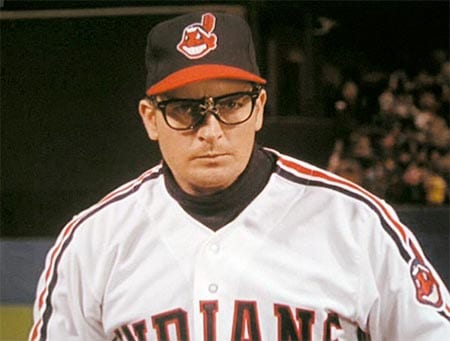
Original Film Rotten Tomatoes Score: 83%
Sequel Rotten Tomatoes Score: 5%
It may be hard to imagine, but back in the late 80’s Charlie Sheen was on his way to becoming a major movie star. Following the serious Platoon, Major League was his next most successful film, and established him as a likeable comedy actor. The sports comedy starred the venerable Tom Berenger and made a good profit on a modest budget. The studio greenlit a sequel, bringing most of the original cast back along with the director while doubling the budget. Expectations were high.
But whatever inspiration took hold during the creation of the first film was completely absent from the second. It was a hollow shell of the original, with unfunny predictable jokes, zero chemistry, and a directionless plot. It was clearly a case of the first film mining all that could have been mined from the situation and leaving very little for a sequel to go on with. It was also a reflection of the approach studios took to making movies in the 90’s, if there was success they would follow it up with a sequel, with no consideration to make sure there was enough creative content to back it up. In other words, this is exactly the type of film which gave sequels a bad name.
- S. Darko: A Donnie Darko Tale (2009)
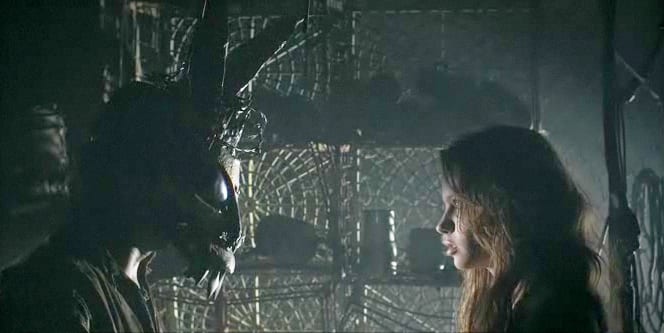
Original Film Rotten Tomatoes Score: 86%
Sequel Rotten Tomatoes Score:13%
I’m including this film on this list not because Donnie Darko was a huge success and could have become the foundation of a major movie franchise, but because the sequel is the definition of unnecessary. Donnie Darko was a mind-bending, smart, and very innovative science fiction film with deep themes and its own unique sense of humor. While it wasn’t necessarily a film with widespread appeal, it has grown a very large cult following over the years.
This makes the decision to make a sequel that much more perplexing. The 8 year period between the two films can be explained by the original film becoming more popular to a point where a studio thought it might be a good idea to make a sequel. But the decision to make a sequel without much connection to the original film does not. In reality the only thing this film shares with the original is the fact that the main character was related to the main character in the first film, and as such experiences similar events. The first film was a self-contained masterpiece, this one tries hard to repeat the same type of plot just to make an extra buck. What a shame.
- Nutty Professor II: The Klumps (2000)
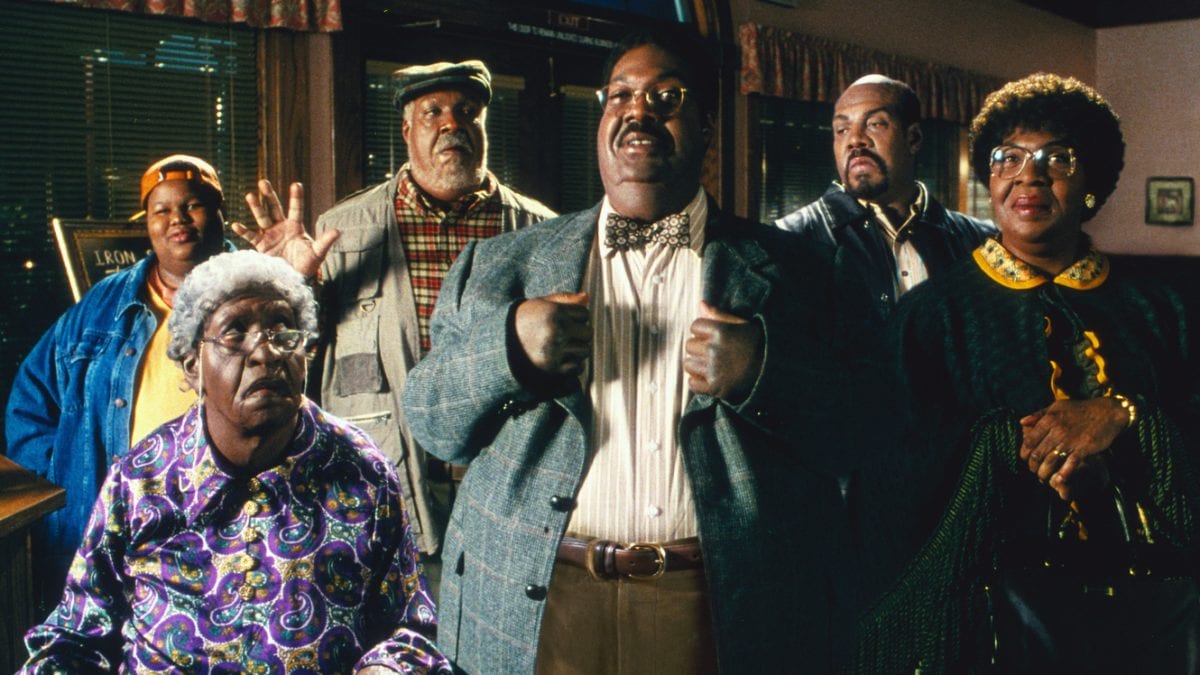
Original Film Rotten Tomatoes Score: 64%
Sequel Rotten Tomatoes Score: 26%
Eddie Murphy was at the height of his fame at the end of the 1990’s before a series of poorly-received films derailed his career as a movie star. You can pinpoint the beginning of his downfall to this film, which was a sequel to The Nutty Professor, which was a huge hit. Whereas that original film was a modern remake of the classic 60’s film by the same name, the sequel didn’t really have any established material to base itself upon. Instead, the film meanders its way through a series of side characters rather than maintaining a singular plotline like in the original.
At the time people praised Eddie Murphy’s performance because the approach was still somewhat new and fresh. Just like in Coming to America, Murphy plays several different characters at the same time with the help of prosthetics and make-up effects. He used the same technique in the original film, and those few scenes in the first film were received so well that the studio decided to make an entire sequel based on them. In many ways the sequel doubles down on cheap humor in lieu of an actual plot. It becomes very childish and lacking genuine wit. Today the charm of this film has worn off, and we wonder how such a funny comedian could have been part of such an uninspiring film.
- Basic Instinct 2 (2006)
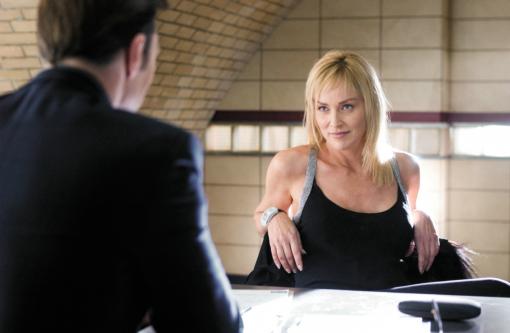
Original Film Rotten Tomatoes Score: 55%
Sequel Rotten Tomatoes Score: 6%
Did you remember that there was a sequel to Basic Instinct, released 14 years after the release of the original film? No? That’s ok, everyone else forgot too. The original film made $350 million at the box office. The sequel made a tenth of that, and only made back half of its budget, which in-turn was twice as much as the original film. This film embodies the terrible sequel in all regards.
Sharon Stone became famous for her role in the original Basic Instinct. This one comes off as just going through the motions, hoping the audience will play along because of the connotation with the original film. It’s another example of Hollywood tacking on more story where it didn’t need to just for the sake of what it thought could be easy profit. But in most cases the original film is such a hit that you can kind of make a case for such behavior, if the sequel is handled competently. But this film tries the two-wrongs approach by not only making a sequel that no one really thought needed to be made in the first place, but bungling the sequel-making process as well.
- Son of the Mask (2005)
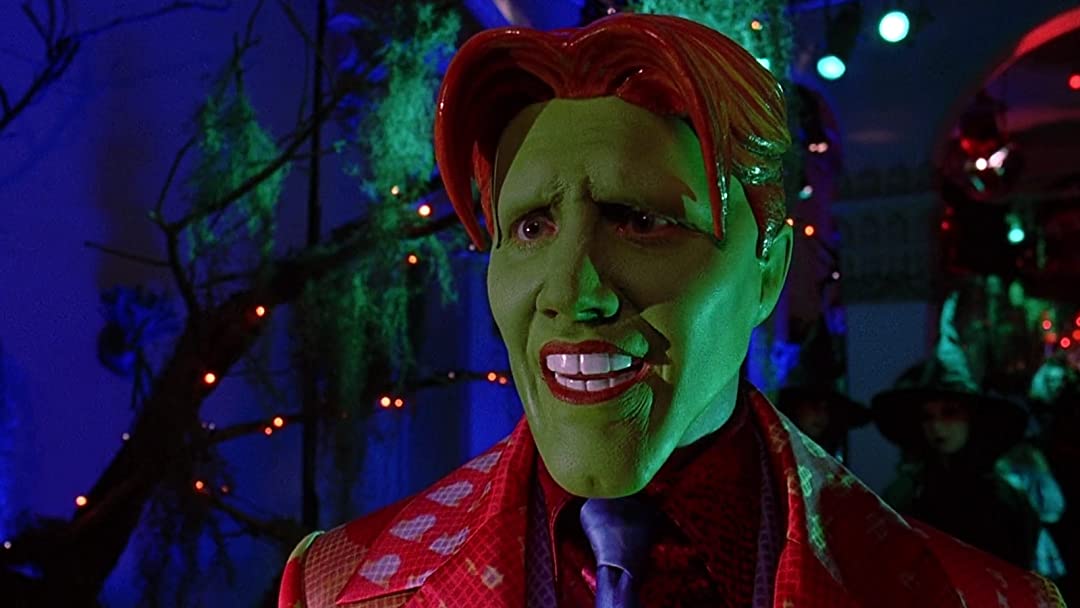
Original Film Rotten Tomatoes Score: 79%
Sequel Rotten Tomatoes Score: 6%
The 90’s was a feeling-out period for the comic-book based movie, and the original Mask was one of the successes, mostly thanks to the comic versatility of a young Jim Carrey. As you might expect, the success of additional Mask films would depend on Carrey’s involvement. After Mr. Carrey decided to move on from a planned sequel, the original plans got shelved and the franchise was mothballed for more than a decade.
The sequel starred Jamie Kennedy, and sported a budget that was as much as 4 times as great as the budget for the original film. Without the involvement of any of the original cast, it felt like a spin-off and audiences stayed away. The film bombed at the box office and critics chastised it for having inappropriate humor for a PG-rated film, as well as being all energy and no substance. It was an example of the studio failing to see how a singular talent (Jim Carrey) can’t be replaced, even if you throw heaps of money on it…
- Exorcist II: The Heretic (1977)
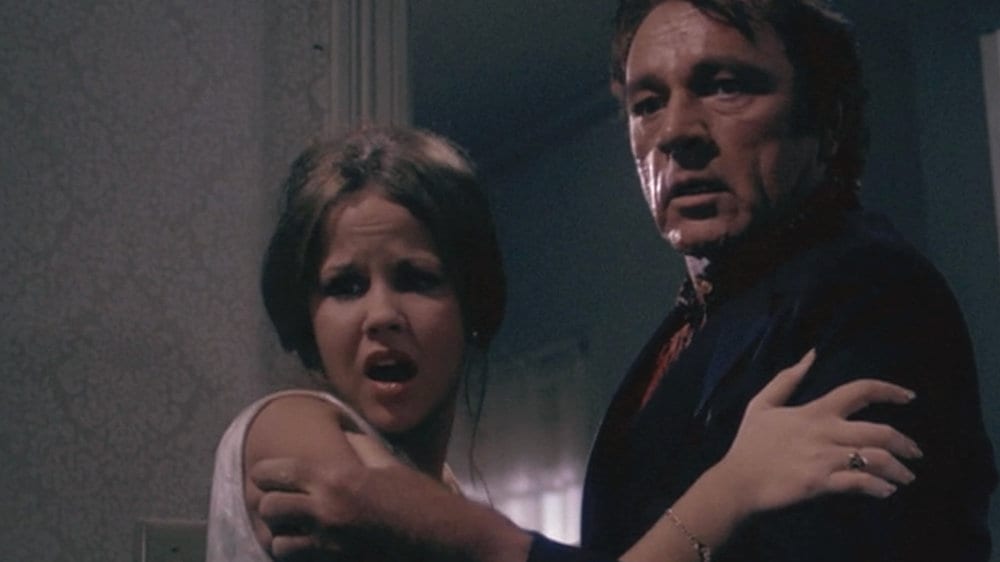
Original Film Rotten Tomatoes Score: 83%
Sequel Rotten Tomatoes Score: 15%
Horror films have a tendency of generating many many terrible sequels. Franchises like Halloween, and Friday the 13th have diluted their original inspirations with loads of low-budget sequels, spin-offs, and remakes. Horror kind of embraces campy production anyway, the thrills come from shock not artistic proficiency. So, in a way you expect a popular horror film to be followed by a sequel delivering less. But that still doesn’t diminish the disappointment of Exorcist II.
The Exorcist is considered to be one of the greatest horror movies ever made. Critics and audiences loved it, and it became a huge hit in theaters. At the premiere of the sequel, the audience couldn’t stop intentionally laughing. The only people it haunted the dreams of were studio executives. Every element, from the acting to the special effects, seems to be intentionally sabotaging it. It’s no wonder it has been called one of the worst movies ever made.
- Caddyshack 2 (1988)
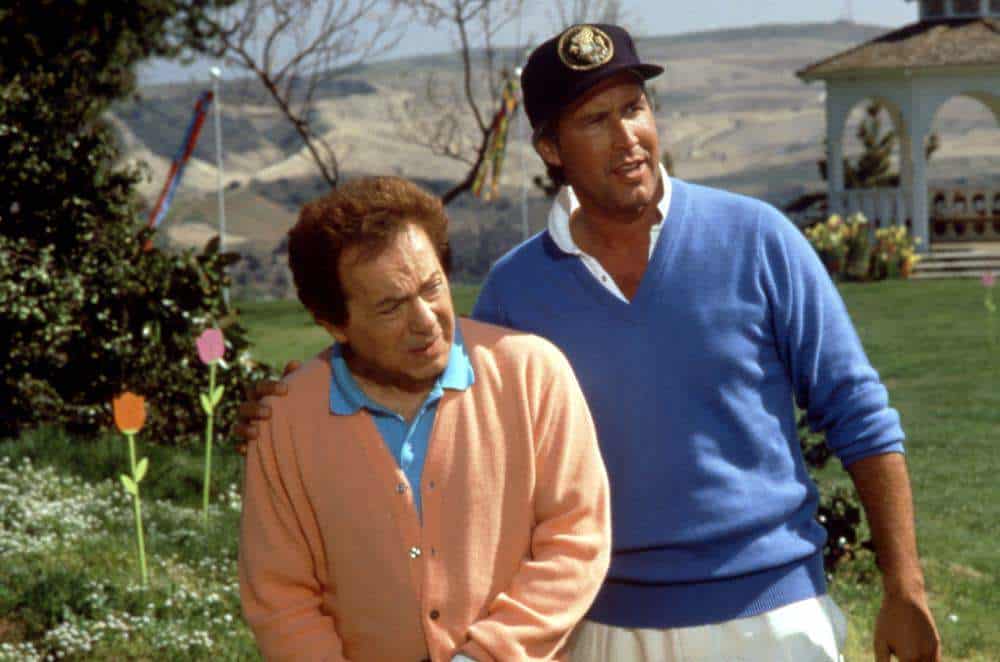
Original Film Rotten Tomatoes Score: 73%
Sequel Rotten Tomatoes Score: 4%
Caddyshack may be one of the most beloved comedies of all time (and one of the greatest sports films ever), but who remembers that there was a sequel which came out 8 years later? The director and writer of the first film, Harold Ramis, was pressured by the studio to create a sequel. He had only agreed if Rodney Dangerfield was involved, and for a period of time Dangerfield was interested. But a falling out between Dangerfield and the studio (including an ugly lawsuit) caused Ramis to back away from the project, but that didn’t stop the studio from moving forward without him. As you could imagine, the non-ideal gestation period for this sequel lead to a downright terrible film.
Chevy Chase is the only actor (let alone director, writer, or producer) from the original film who returns for the sequel, and his role is little more than a glorified cameo. The studio brought in new actors to play new characters who were suspiciously similar to the characters in the original film, but even comedy greats such as Dan Akroyd and Jackie Mason weren’t enough to right this ship. The film was a flop in theaters where critics lambasted it for a lack of originality, and inspiration. It was yet another example of a sequel going through the motions because the studio thought it would be a good idea when everyone else thought otherwise.
- Staying Alive (1983)
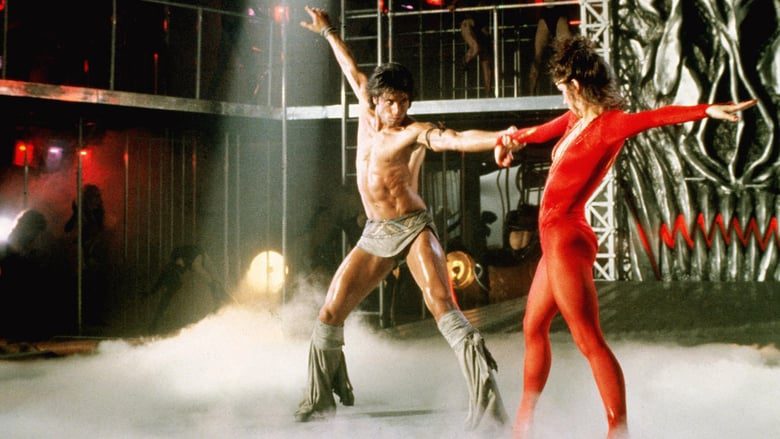
Original Film Rotten Tomatoes Score: 82%
Sequel Rotten Tomatoes Score: 0% (!)
Staying Alive has the dubious record of being the oldest film on Rotten Tomatoes with a 0% rating. It very well could have also out-grossed all of the films with 100% ratings. Staying Alive was an inexplicable success at the box office, despite being very very unloved by audiences. This sequel to the successful Saturday Night Fever was directed by Sylvester Stallone (and featured songs sung by his brother). The film tried to continue the story of the protagonist in the original film, but didn’t have much of a compelling reason to do so.
This was an example of a delayed sequel which only made it to theaters only because of the people involved and the power they had. The writer of the original film tried to get a sequel made immediately after the release of the 1977 original film, but John Travolta didn’t like the script and wouldn’t commit. To try and convince him, the studio hired Stallone at Travolta’s request, and in return Stallone made changes to the script to please Travolta. Clearly they were so focused on trying to get the sequel made, they failed to consider if the sequel should have been made in the first place.
- Highlander 2: The Quickening (1991)
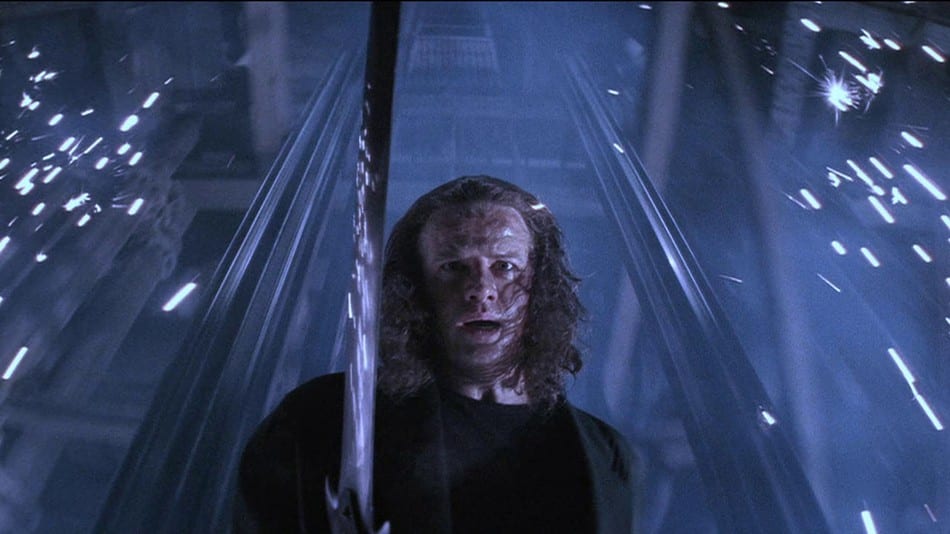
Original Film Rotten Tomatoes Score: 69%
Sequel Rotten Tomatoes Score: 0% (!)
When a later sequel in a franchise simply ignores the plot of an earlier sequel, you know that earlier sequel had significant problems. Such was the case with the sequel to the original Highlander, and “significant problems” might not be suitable to describe the disaster of this film. Things started out well enough. There were good intentions to make a sequel to the cult-hit original film; the director was back, the creative team was mostly the same, and the surviving cast returned.
But things started going bad once production started when two of the main characters got injured during a stunt. Then some of the planned stunts had to be changed because they couldn’t be completed as originally planned. The production took place in Argentina where rapid inflation towards the end of filming led to significant insurance issues, and as a result the bonding company stepped in to take over production as representative of the film’s investors.
As you might imagine, having a new party step in at the last minute to finish a film is a recipe for disaster, especially when the party has little knowledge of film production and little concern for continuity with the original film. Working with what was completed at the time, the bonding company patched together a final cut and shipped it off to distribution without any input from the film’s original creative team.
The resulting product was full of plot holes, story elements which walked back things that had been established in the first film, and contradictions to itself. Audiences were understandably perplexed, fans of the original film were outraged, and critics couldn’t help but make very crude jokes at the film’s expense. It’s no wonder the film’s director walked out of the premiere 15 minutes in.
- Speed 2: Cruise Control (1997)
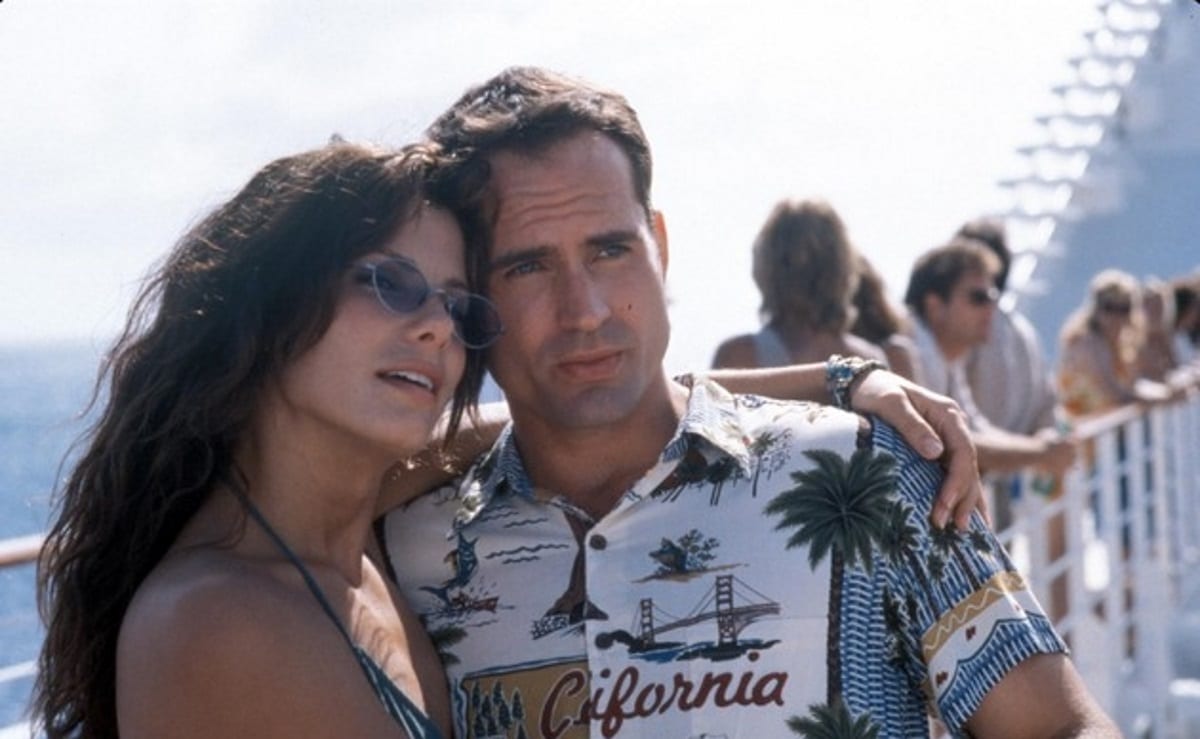
Original Film Rotten Tomatoes Score: 94%
Sequel Rotten Tomatoes Score: 4%
If you combine all of the lessons about what can go wrong with a sequel as detailed by the previous 9 entries on this list, you just might touch on the catastrophe that was Speed 2. Start with studio pressure to make a sequel of a hit film which already had its narrative loop completed. Indeed, none of the contracts of any of the main cast or creative team had stipulations for sequels. But when the first film made bank at the box office, the studio began seeing dollar signs, and pressured director Jan de Bont to make a sequel. He had to agree because he had a contract with the studio to make a certain number of films. They got Sandra Bullock to agree thanks to a huge salary and an agreement to fund her next film.
Unlearned lesson #2: not getting the original cast back for the sequel. Keanu Reeves declined because he didn’t want to do another action movie, despite the vast sums of money they wanted to pay him. The studio didn’t take the rejection well and launched a smear campaign against Reeves. Without the star of the first film they should have just stopped production altogether, but instead they brought in Jason Patric as a (low cost) replacement and clumsily wrote Reeve’s character out of the film in the very first scene. Problem solved, right?
Unlearned lesson #3: not saying no. With the success of the first film, director Jan de Bont rethought his earlier rejection of directing a sequel and embraced the role, especially because he would have full creative control. The creative team reviewed hundreds of proposals for a sequel to Speed, which you think would be pretty easy to come up with. They didn’t choose any of those proposals, and instead moved forward with an idea de Bont came up with on his own thanks to a bad dream: setting the film on a cruise ship.
This decision would become one of the most ridiculed big-budget moviemaking decisions of all time. Of all of the things they could have done with a sequel to Speed, the team decides to set it on a ship that can only travel 20 mph. Yes, the sequel to a movie about a bus that can’t slow down takes place on one of the slowest types of transportation vehicles on the planet. Even worse, the film’s finale was planned to be a big explosion-spectacular with the ship crashing into a sea-side village.
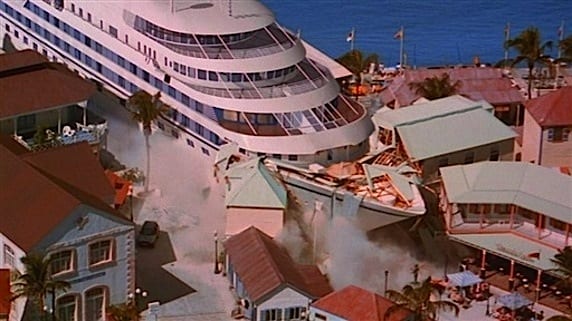
The film’s climax is one of the most expensive and extensive stunts ever planned. The production team built an entire town in the Caribbean to crash a fake full-scale ship nose into, to the sum of $5 million. Mother nature promptly told them it was a really bad idea by destroying it with a hurricane. As a result, it had to be rebuilt, and this time hurricane-proofed. When all was said and done, this entire sequence would eat up about a quarter of the film’s entire budget.
Add in the mishaps of film production that typically take place with poorly-directed sequels (injured cast, injured stunt-men, filming delays, script changes, poor acting), and you have a recipe for disaster. Speed 2 did make some money at the box office, but not enough to cover the film’s overblown budget. The film would go on to win Golden Raspberry awards for Worst Picture, Worst Director, and Worst Script.
Speed 2 ends up as my #1 pick for worst sequel because not only was the film itself terrible, but it was overblown, boorish, and just plain stupid. On top of everything that it does wrong, it seems like a sequel to Speed should have been relatively easy to make. This sequel had opportunity after opportunity to stop and think about its actions, and yet it still pressed forward in making some of the most incredibly stupid moviemaking decisons of all time. Even today, when we somewhat celebrate silly overblown blockbusters, Speed 2 is still a joke.

